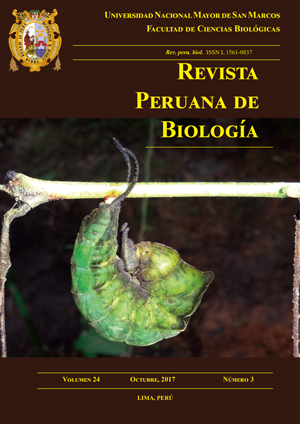Biochemical study of venom sea anemone Phymactis papillosa (Actiniidae)
DOI:
https://doi.org/10.15381/rpb.v24i3.13901Keywords:
poison, sea anemone, toxins, neurotoxinsAbstract
In this work, the poison of Phymactis papillosa collected in Ancón bay has been studied biochemically. The venom was obtained by hypotonic shock and then lyophilized. Electrophoretic analysis of the soluble poison showed the presence of 5 protein bands with molecular weights between 5 and 25.1 kDa.
The soluble venom was fractionated by filtration chromatography on a Sephadex G-50 column, yielding four protein peaks (I, II, III and IV). In the soluble venom and collected fractions was measured protease activity, phospholipase, hyaluronidase, acid phosphatase and alkaline phosphatase; as well as hemolytic and neurotoxic activity. Proteolytic activity on casein was found in the soluble venom and peaks I and III. Was not detected phospholipase activity, hyaluronidase, acid phosphatase and alkaline phosphatase. Hemolytic activity on human red cells tested, was found in the soluble venom and peak II. Finally, the soluble venom as the peak III showed be neurotoxic when injected into white mice intraperitoneally. It is concluded that the soluble venom of P. papillosa has proteolytic, hemolytic and neurotoxic activity.
Downloads
Downloads
Published
Issue
Section
License
Copyright (c) 2017 Antony Cuya, Enrique Escobar

This work is licensed under a Creative Commons Attribution-NonCommercial-ShareAlike 4.0 International License.
AUTHORS RETAIN THEIR RIGHTS:
a. Authors retain their trade mark rights and patent, and also on any process or procedure described in the article.
b. Authors retain their right to share, copy, distribute, perform and publicly communicate their article (eg, to place their article in an institutional repository or publish it in a book), with an acknowledgment of its initial publication in the Revista Peruana de Biologia.
c. Authors retain theirs right to make a subsequent publication of their work, to use the article or any part thereof (eg a compilation of his papers, lecture notes, thesis, or a book), always indicating its initial publication in the Revista Peruana de Biologia (the originator of the work, journal, volume, number and date).






